Dr. rer. nat. Larissa Dloczik, Tel.
(0561) 970 40447 (Kassel, GERMANY),
E-Mail:
webmaster@sanfte-zahnklammern.de
Last
update: 14.02.2019

|
Dr. rer. nat. Larissa Dloczik, Tel.
(0561) 970 40447 (Kassel, GERMANY), |
|
Own prototypes of removable braces
This
is not a commercial
brochure for removable braces, but a collection of ideas and
prototypes, which could be developped into budget jaw orthopedic
solutions with low risk and high patient comfort.
Emphasis is here
just on their principles. The prototypes are not professionally
machined, are mostly not made on plaster models of „realistic“
cases and may comprise some wrong details.
Some of these appliances have only small plastic parts. These are better made by casting a viscous plastic mixture, than by mixing plastic powder and liquid on the model. Wax boundaries prevent this mixture from covering adjacent parts which should stay plastic-free.
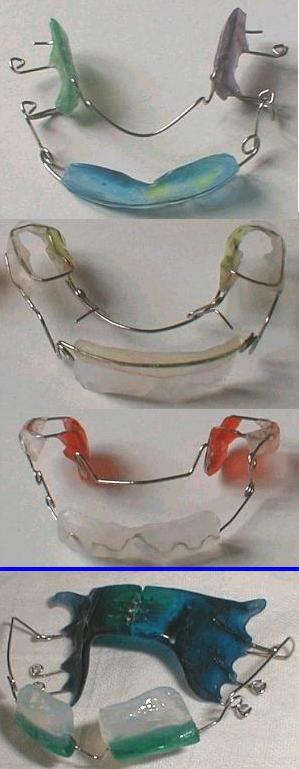 |
1.
AN
F
J
Removable
flexible lip bumpers From
top to bottom: |
|
2. AN
F
J
E
Lightweight
(spring) expanders If anchoring teeth are too conical or not yet fully erupted, so that the appliance fits only loosely, then tiny white attachments can be glued to these teeth, as are common in Invisalign® or similar therapies for certain cases. In contrast to bands or brackets, these neither hurt inside the cheeks, nor hamper to keep these teeth clean. The appliance will snap in firmly on them. |
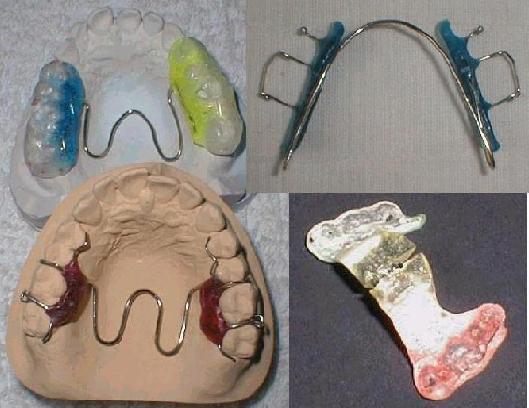 |
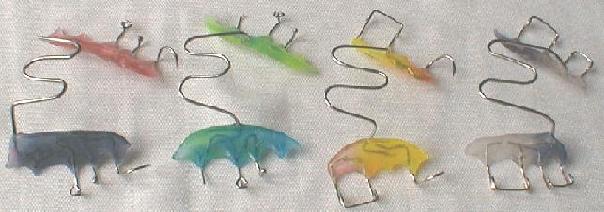 |
3. F
J
E
Silicone
rubber in removable
orthodontics
Silicone
rubber can be stuck to plate appliances by use of a primer. Such a
plate can deliver a surrounding force to teeth which have been
aligned on the plaster model before (setup / aligner technique). This
rational technique would allow to correct tilted or twisted teeth
already in mixed dentition, and would not require the manufacture of
wire spring elements (but allow the use of screw elements, if
advised). Derotations are also possible. If teeth lack a grip in the
desired direction of force, white
attachments can be added as a grip, see 2.
In
the
mainly orange specimen, silicone comprises 8 lower teeth, to re-align
a beginning adult´s crowding, after slight stripping of these teeth.
In the blue specimen, it comprises 6 upper teeth, also from both
sides. This patient had a holistic treatment with prefabricated
elastic trainers before, but a slight frontal crowding remained
(perhaps no size of the trainers fitted perfectly). Moreover, his
occlusion retained his left bicuspids in their visibly rotated
positions. The silicone furnishing shown here is for the first of 2
or 3 derotation steps.
A
further application of compounding silicone to plastic is to increase
the efficiency of functional jaw orthopedic appliances, e.g.
activators against deep bite.
To
keep the silicone clean, it is recommended to brush it daily with
baking soda.
Find detailed instructions with further examples (in
German) from Fachlabor
W. Paulus, Burgbernheim: www.positioner.de
> Arbeiten mit Silikon
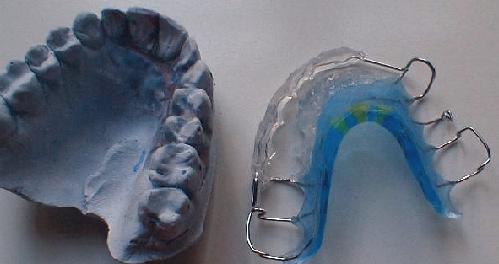 |
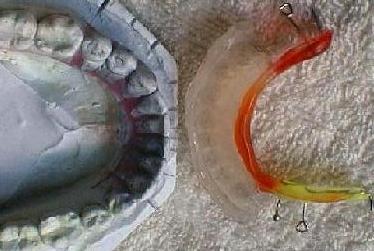 |
|
4.
J
E
Recovery
of lateral gaps: simply built distal plate appliances A
simple transversal expansion would not solve these problems and
would be wrong here. Instead, the migrated teeth should be shifted
back against the tide (distalized) to the places where they
belong. At removable appliances, this requires good grips. Arrow
clasps in series (see inset in pink) are well-proven, but
difficult to make unless with special tools. Due to their
deep-grip, they are recommended if the grasped teeth should still
grow higher. But if not, then a good grip is easier to make by a
simple wire frame with surrounding polymer around those teeth
which are to be „screwed back“. This is shown here for a
half-closed milk-5 gap (transparent-blue plate) and against
crowding of the cuspids (red-yellow plate, should be modified when
permanent 5s grow). The polymer tenon in the residual gap was
simply cut through. It needs to be carved out gradually when the
permanent tooth appears. Additional claspy elements in the frontal
region are recommended, rather than a frontal bow. If both sides
require distalization, a lip bumper (see 1.
above)
can be attached to the lower or also upper plate to relieve the
frontal teeth from counter-force. |
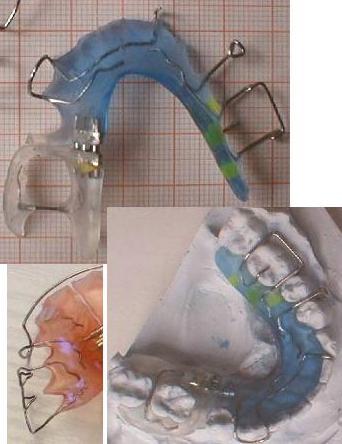 |
|
|
|
|
Important: to create space for crowded teeth, distalizing all side teeth should be second choice, since it just shifts the lack to the region of the wisdom teeth. Stimulating jaw growth during growth phase would be healthier. A little additional space can be created rather harmlessly by narrowing (stripping, slicing) the teeth, to an extent which depends on their shape. |
|
|
5. F
J
E
Lightweight
retainers |
|
|
|
|
from one or both sides, as
for the upper retainer here. The pair of connecting bars of this
preliminary specimen is
too thick, 0.9 mm wire instead of 1.1 mm would be sufficient, and
the frontal bar should cross the palate 1 toothwidth more
backward, for not interfering with the tongue. |
|